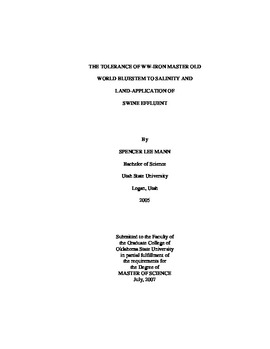| dc.contributor.advisor | Kizer, Michael A. | |
| dc.contributor.author | Mann, Spencer Lee | |
| dc.date.accessioned | 2014-02-25T00:21:01Z | |
| dc.date.available | 2014-02-25T00:21:01Z | |
| dc.date.issued | 2007-07-01 | |
| dc.identifier.uri | https://hdl.handle.net/11244/7954 | |
| dc.description.abstract | The purpose of this study is to fill the existing information gap on the tolerance of WW-Iron Master Old World Bluestem to salinity and land-application of swine effluent. Analysis of salinity tolerance of Old World bluestems was evaluated from experiments of root and shoot exposure to various saline solutions as well as a statistical examination of data provided from land in the Conservation Reserve Program. The salt tolerance study indicated that Old World bluestem is a highly salt sensitive plant. The salinity threshold for Old World bluestem was found using the piecewise linear response model to be 1 ds/m and the fractional yield decline per unit increase in salinity beyond the threshold was 21%. Additionally, a mineral analysis of the root and shoot portions of the studied plants indicated an interaction between K+ and Na+ concentrations in the root zone of Old World bluestem. The Na+ accumulation in the shoots was much greater than in the roots, indicating that Old World bluestem is unable to restrict Na+ transport. From the field study examining both foliage and root exposure to effluent dillutions, no effect on plant growth was found to be statistically significant. However, the statistical analysis of both the reflectance and dry weight data did indicate that the time of day of the application was significant at a 10% alpha level. Greenhouse studies investigating salt burn effects on foliage never produced a statistically significant effect of salt or swine effluent dilutions on Old World bluestem. Statistical evaluation of data provided from land in the Conservation Reserve Program revealed that both the soil nitrate nitrogen (lbs/acre) and copper (mg/l) in soil were significantly correlated with stand loss. Evaluation of the model based on carefully selected variables yielded effluent values of EC (umho/cm) and chloride (mg/l) as potentially significant variables. | |
| dc.format | application/pdf | |
| dc.language | en_US | |
| dc.publisher | Oklahoma State University | |
| dc.rights | Copyright is held by the author who has granted the Oklahoma State University Library the non-exclusive right to share this material in its institutional repository. Contact Digital Library Services at lib-dls@okstate.edu or 405-744-9161 for the permission policy on the use, reproduction or distribution of this material. | |
| dc.title | Tolerance of Ww-iron Master Old World Bluestem to Salinity and Land-application of Swine Effluent | |
| dc.type | text | |
| dc.contributor.committeeMember | Redfearn, Daren | |
| dc.contributor.committeeMember | Stone, Marvin | |
| osu.filename | Mann_okstate_0664M_2374.pdf | |
| osu.college | Engineering, Architecture, and Technology | |
| osu.accesstype | Open Access | |
| dc.description.department | Biosystems and Agricultural Engineering | |
| dc.type.genre | Thesis | |
| dc.subject.keywords | salinity tolerance | |
| dc.subject.keywords | swine waste | |
| dc.subject.keywords | bluestem | |
| dc.subject.keywords | grasses | |
| dc.subject.keywords | salt burn | |
| dc.subject.keywords | old world bluestem | |
